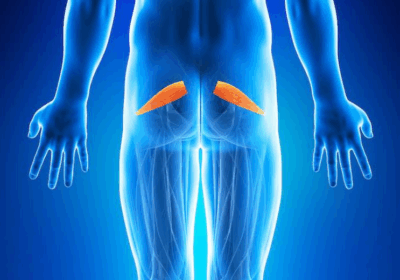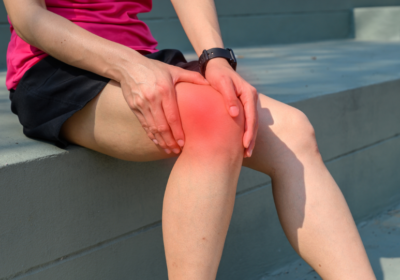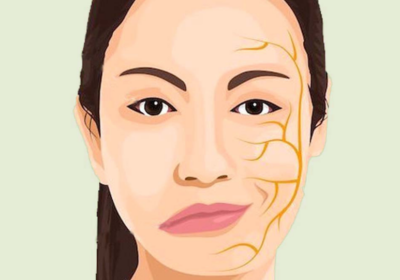SYRINGOMYELIA RELIEF WITH AYURVEDA;BALANCE,HEAL,THRIVE!
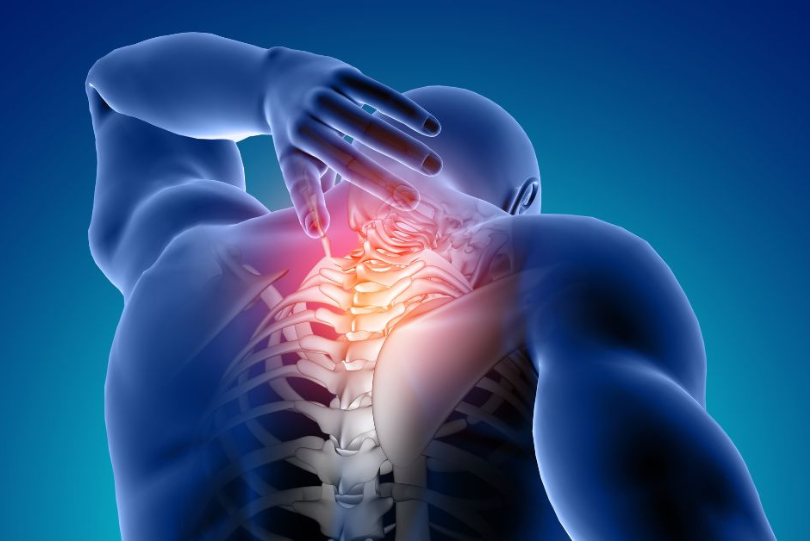
Syringomyelia is a chronic neurological disorder characterized by forming a fluid-filled cyst, known as syrinx, within the spinal cord. Over time syrinx can expand and elongate, leading to progressive damage to the spinal cord by compressing and destroying nerve tissue.
PATHOPHYSIOLOGY:
- The syrinx develops in the central canal or parenchyma of the spinal cord.
- When the flow of cerebrospinal fluid (CSF) is disrupted, it may accumulate.
- Neurological issues are caused by pressure on neighboring nerve fibers caused by syrinx expansion.
CAUSES OF SYRINGOMYELIA
The exact cause varies depending on the underlying problems preventing regular flow of cerebrospinal fluid (CSF). The causes fall into two major categories:
Congenital (primary) diseases and Acquired (secondary).
I)CONGENITAL CAUSES(PRIMARY SYRINGOMYELIA):
- These are congenital defects that disrupt regular CSF flow, eventually resulting in the development of syrinx.
A)Chiari Malformation(Type 1):Most common cause;
- When the cerebellar tonsils, the lowest portion of the brain, protrude into the spinal canal, it results in Chiari malformation.
- This prevents the normal passage of cerebrospinal fluid (CSF) between the brain and spinal cord, which results in fluid buildup in the spinal cord and syrinx.
- As the syrinx enlarges during adolescence or maturity, symptoms manifest.
B)Congenital Spinal Cord Anomalies:
- Some people have birth defects in the development of their spinal cords, which can cause a syrinx to occur.
- Tethered cord syndrome (abnormally linked spinal cord to surrounding structures) and spinal dysraphism (abnormal closure of neural tube) are two examples.
C) Hydrocephalus:
- A disorder in which the brain’s ventricles become overloaded with CSF.
- Elevated intracranial pressure can cause syrinx development by interfering with CSF flow.
D) Dandy-walker syndrome:
- Congenital brain abnormalities that impact the CSF and cerebellar pathways may result in the development of syrinx.
II)ACQUIRED CAUSES(SECONDARY SYRINGOMYELIA):
These can be brought on by an accident, infection, tumor, or other illness that affects the flow of CSF.
A) Post Traumatic Syringomyelia, or spinal cord injury (PTS):
- It occurs following a spinal cord injury, sometimes for months or even years.
- Trauma causes scarring in the spinal cord, which obstructs CSF flow and causes syrinx development.
- Progressive weakness, sensory loss, and increasing pain are possible symptoms.
B)Spinal Cord Tumors:
- CSF circulation may be impeded by tumors in or close to the spinal cord, such as ependymomas or astrocytomas.
- Fluid accumulation and syrinx development above or below the tumor site may result.
C)Meningitis and Arachnoiditis(Inflammation and scarring):
- Inflammation from meningitis, an infection of the meninges encircling the brain and spinal cord, can result in scarring.
- Chronic inflammation of the arachnoid membrane, or arachnoiditis, impairs CSF circulation and may result in the formation of a syrinx.
D)Spinal Cord Cysts or Abscesses:
- Syringomyelia can result from conditions that compress the spinal cord and interfere with the passage of CSF, such as spinal abscesses or arachnoid cysts.
E)Post-Surgical Complications:
- Certain spinal procedures, particularly those that involve tumor removal or decompression, may unintentionally change CSF flow, which could result in a syrinx.
F)Spinal Degenerative Diseases:
- The risk of syringomyelia can be raised by conditions such as cervical spondylosis, and an age-related deterioration of the cervical spine, which can contribute to CSF flow restriction.
MECHANISM OF SYRINX FORMATION:
Despite the reason, there is a common pattern to how a syrinx forms:
- Disruption of CSF Flow: When a barrier prevents the CSF from moving freely. (for instance, trauma, tumor, or Chiari malformation).
- Pressure Changes: Unusual fluid buildup in the spinal cord is caused by altered CSF pressure dynamics.
- Syrinx Expansion: As the fluid-filled chamber grows, spinal cord tissue is compressed and harmed.
- Progressive Neurological Symptoms: As the syrinx grows, nerve fibers involved in sensation, movement, and autonomic processes are impacted.
TYPES OF SYRINGOMYELIA:
1. Chiari-Associated Syringomyelia:
The most prevalent type of syringomyelia is called Chiari-associated syringomyelia, which is brought on by Chiari Malformation Type 1 (CM-1). In this disorder, the cerebellar tonsils are displaced downhill into the upper spinal canal, obstructing the passage of cerebrospinal fluid (CSF) and creating a fluid-filled cyst (syrinx) inside the spinal cord.
Clinical Symptoms:
a)Sensory Symptoms:
- Dissociated Sensory Loss: Touch and proprioception remain intact, but the “cap-like” distribution (shoulders, arms, and upper chest) loses its ability to feel pain and temperature.
- Usually beginning in the hands, tingling and numbness spread to the arms.
b)Motor Symptoms:
- Muscle atrophy and weakness: Fine motor impairment and trouble grasping items are the results of weakness that starts in the hands and arms.
- Hand Clumsiness: Patients may have trouble handling utensils, writing, or buttoning clothes.
- Spasticity and Increased Reflexes: Leg stiffness and hyperreflexia may result from the syrinx’s expansion to the lower spinal cord.
c)Autonomic Dysfunctions:
- Bladder dysfunction: In more severe situations, urinary urgency, retention, or incontinence.
- Fecal incontinence or constipation are examples of bowel dysfunction.
- Sweating Abnormalities: Reduced or excessive perspiration brought on by autonomic nerve dysfunction.
d)Pain And Headaches:
- A frequent symptom of syrinx compression and tension associated with Chiari malformation is neck and shoulder pain.
- Occipital Headaches: Because of elevated CSF pressure, they get worse with cough, sneeze, or strain.
e)Scoliosis:
- Observed in younger patients, especially those with idiopathic scoliosis who are adolescents.
- Muscle imbalance and spinal curvature result from the syrinx’s impact on the motor pathways in the spinal cord.
2.Non-Communicating Syringomyelia(Post Traumatic or Idiopathic Syringomyelia):
Cerebro Spinal Fluid (CSF) flow restriction, spinal cord pathology, or trauma are the most common causes of non-communicative syringomyelia.
The following are the main causes:
a)Spinal cord Trauma:
- Syrinx development may result from scarring or restriction of CSF flow caused by prior spinal cord injuries (e.g., falls, accidents).
- After an accident, post-traumatic syringomyelia (PTS) may appear months or years later.
b)Spinal Cord Tumors:
- Syrinx development can result from tumors in or close to the spinal cord, such as ependymomas or astrocytic tumors, which block CSF flow.
c)Congenital Malformations(Other than Chiari Malformation):
- Tethered Cord Syndrome: Movement and CSF flow are restricted in tethered cord syndrome, a disorder in which the spinal cord is improperly connected to surrounding structures.
- Diastematomyelia: CSF circulation is impacted by diastematomyelia, a congenital spinal cord divided by a fibrous or bony protrusion.
d)Arachnoiditis and Meningitis:
- Chronic inflammation is brought on by infections. (such as bacterial meningitis or tuberculosis) or autoimmune disorders can result in scarring and blockage of the CSF flow.
e)Post-Surgical Changes:
- Syrinx development can result from changes in CSF dynamics caused by spinal procedures, particularly those requiring decompression or tumor removal.
f)Spinal Cord cysts or cavitations:
- Syringomyelia can occasionally result from Hydromyelia, a disorder in which the spinal cord’s central canal dilates abnormally.
g)Idiopathic Syringomyelia:
- In certain instances, no underlying pathology is found, and the precise causes are still unknown.
Clinical Symptoms:
- Weakness in the arms and legs develops gradually.
- Lower limb spasticity and improved muscular tone.
- Neck and shoulder pain.
- Gastrointestinal and bladder issues in more severe situations.
3. Congenital Syringomyelia:
Congenital syringomyelia is a neurological disorder defined by the production of fluid-filled cavities or cysts(syrinx) within the spinal cord due to developmental defects. The main cause of this is structural brain and spinal cord anomalies, especially Chiari malformation type 1.
Causes:
Hereditary components may be present in certain congenital instances.
- Neural tube defects: Structural problems that predispose to syringomyelia can result from improper neural tube closure during embryonic development.
- The most frequent reason, why brainstem structures impede normal CSF circulation, is Chiari malformation.
- Maternal Factors: Pregnancy-related diseases such as diabetes, infections, or teratogenic exposure might result in congenital abnormalities.
Clinical Features:
- Children’s delayed motor milestones.
- Imbalance and weakening of the muscles.
- Club foot and scoliosis are foot abnormalities.
- Decreased sensitivity to temperature and pain.
4. Post Traumatic Syringomyelia:
After spinal cord injury (SCI), a fluid-filled cyst (syrinx) develops inside the spinal cord in post-traumatic syringomyelia (PTS). Due to spinal cord compression and disruption of normal cerebrospinal fluid, this cyst may progressively get larger, resulting in increasing neurological impairments.
Causes:
- Fractures, dislocations, and penetrating injuries (such as gunshot or stabbing wounds) are examples of spinal cord trauma.
- Scar development following spine procedures is a postoperative problem.
- The long-term strain on small repetitive spinal cord lesions is known as repetitive microtrauma.
Clinical Symptoms:
a)Sensory loss(Dissociated sensory impairment):
- Loss of temperature and pain perception as a result of spinothalamic tract injury.
- Preservation of proprioception and touch (posterior column intact).
b)Motor weakness and spasticity:
- Hand spasticity, atrophy, and progressive weakness.
- Muscle atrophy (evidence of reduced motor neurons at the syrinx level).
- Hyperreflexia (signs of upper motor neurons below the syrinx).
c)Autonomic dysfunction:
- Bladder or bowel disorders.
- Dysfunction in sexual interactions.
- Excessive perspiration (hypohidrosis or anhidrosis).
d)Neuropathic pain:
- Chronic pain in the affected area is either scorching or stabbing type.
e)Spinal deformities:
- Muscle imbalance can lead to the development of kyphoscoliosis.
5. Syringobulbia:
A neurological disorder called syringobulbia is typified by fluid-filled cavities or syrinxes in the brainstem, especially in the medulla oblongata. Because it is similar to syringomyelia, this disorder is frequently linked to it. Because syringobulbia disrupts brainstem function and cranial nerve networks, it can cause severe neurological impairments.
Cranial Nerve Involvement:
- Dysphagia(difficulty swallowing): Due to involvement of glossopharyngeal(CN IX) and vagus nerves(CN X).
- Dysarthria(Speech difficulties): Weakness or paralysis of tongue and facial muscles(CN VII, IX, X, XII).
- Horner’s syndrome: Involvement of sympathetic fibers can lead to ptosis(drooping eyelid), miosis(constricted pupil), and anhidrosis(lack of sweating).
- Facial weakness or Sensory loss: Due to trigeminal(CN V)and facial nerve(CN VII) involvement.
Brainstem Dysfunction:
- Nystagmus and vertigo: Damage to vestibular nuclei.
- Breathing and Autonomic dysfunction: If the medullary respiratory centers are affected, it can lead to breathing difficulties.
- Ataxia(Loss of coordination): Disruption of brainstem connections to the cerebellum.
- Pain and temperature sensory loss: Often affects one side of the face(trigeminal nerve) and the opposite side of the body(spinothalamic tract involvement).
DIAGNOSIS OF SYRINGOMYELIA:
A fluid-filled cavity (syrinx) that forms inside the spinal cord is a defining feature of syringomyelia. Imaging scans, clinical evaluation, and occasionally other procedures to evaluate neurological function are used to diagnose syringomyelia. A thorough description of the diagnostic can be found below.
1. Clinical Evaluation:
a)Patient History: Begin with a detailed medical history to identify symptoms associated with syringomyelia. Common symptoms include:
- Progressive numbness and weakness, particularly in the hands and arms.
- Loss of temperature and pain perception in a “cap-like” pattern across the upper limbs and shoulders.
- Chronic back, shoulder, and neck pain.
- Muscular rigidity and atypical reflexes.
- Bladder and bowel problems in more severe situations.
- Symptoms, such as headaches and dizziness, are linked to Chiari malformations.
b)Physical and Neurological Examination:
A neurological examination is performed to assess:
- Muscle weakness and atrophy.
- Anomalies of the reflexes (areflexia or hyperreflexia).
- Decrease of touch sensitivity but preservation of temperature and pain perception.
- Problems in gait and coordination.
2. Imaging Studies:
a)Magnetic Resonance Imaging(MRI):
The best method for identifying syringomyelia is magnetic resonance imaging (MRI). It offers fine-grained pictures of the spinal cord and its surroundings.
- The syrinx appears as a distinct, fluid-filled cavity inside the spinal cord on a T1-weighted MRI.
- The syrinx is visible as a strong signal inside the spinal cord on a T2-weighted MRI.
- Gadolinium-enhanced MRI, or MRI with contrast, aids in ruling out infection, inflammation, and tumors.
Special MRI Techniques:
- MRI: Assess the flow of cerebrospinal fluid (CSF), which is especially helpful when a suspected chiari malformation is present.
b)Computed Tomography(CT Scan):
- Though less sensitive than MRI, it could be employed in its absence.
- Can aid in the detection of skeletal anomalies, including bone deformities and spinal abnormalities like scoliosis.
c)X-rays:
- May help to identify associated spinal abnormalities, such as scoliosis or bone malformations.
3. Additional Diagnostic Tests:
a)Electromyography(EMG)and Nerve Conduction Studies(NCS):
- Help assess nerve and muscle function.
- Able to differentiate peripheral neuropathies from syringomyelia.
b)Lumbar Puncture(Spinal Tap):
- Infrequently carried out, but could aid in determining the content and pressure of CSF.
- Generally not advised unless there is a suspicion of an infection or inflammation.
c)Genetic Testing:
- When congenital problems such as connective tissue diseases or Chiari malformations are detected.
DIFFERENTIAL DIAGNOSIS:
Syringomyelia must be differentiated from other neurological conditions, such as:
- Multiple sclerosis(MS): MRI and CSF analysis help distinguish MS from syringomyelia.
- Spinal Cord Tumors: Contrast-enhanced MRI differentiates tumors from syrinx cavities.
- Amyotrophic lateral sclerosis(ALS): EMG helps differentiate ALS from syringomyelia-related weakness.
- Peripheral Neuropathy: Nerve conduction studies help rule out peripheral causes of sensory loss.
TREATMENT OF SYRINGOMYELIA IN MAURYA AYURVEDA:
Our hospital specializes in providing all-encompassing therapies that are designed to promote quality of life and restore motor function through the use of panchakarma procedures, physiotherapy, acupuncture, and ayurvedic medications.
INTERNAL TREATMENTS GIVEN IN OUR HOSPITAL:
- Varanadi Kashayam Tab.
- Shaddharanam Tab.
- Siva Gulika.
- Rasna Shundyadi Kashayam.
- Pranada Tablet.
- Rasna shundyadi Kashayam Tab
- Vasulax Tab.
EXTERNAL TREATMENTS GIVEN IN OUR HOSPITAL:
PODI KIZHI:

The herbal powders used in the ayurvedic treatment PODI KIZHI, also known as CHOORNA PINDA SWEDAM, are heated, wrapped in a cotton bolus, and massaged into the body. In our hospital, KOLAKULATHADI CHOORNAM is typically used for Podi Kizhi. It usually takes 30 to 60 minutes.
Benefits of Podi Kizhi:
- It reduces pain or discomfort and releases tense muscles.
- It lessens muscle stiffness and spasms.
- It increases circulation.
- It enhances mobility.
- It aids in detoxification.
UDWARTHANAM:

In Udwarthanam, dry medicinal powders are applied to the body and aggressively massaged. This is accomplished by using KOLAKULATHADI CHOORNAM or KOLAKULATHADI together with TRIPHALA.
Benefits of Udwarthanam:
- It improves circulation.
- It aids in muscle strength and tone.
- It helps in the reduction of muscle spasticity.
- It loosens up tight muscles and joints and improves the range of motion.
NADI SWEDAM:
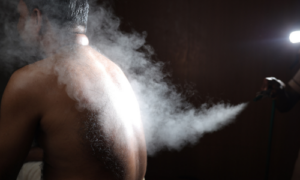
Using a hose or tube, therapeutic steam is administered to certain body areas in Nadi Swedam, a type of sweating therapy or sudation treatment. It is regarded as one of the best remedies in Ayurveda for a variety of diseases, including musculoskeletal disorders, stiffness, cramping in the muscles, and other conditions brought on by an imbalance between the Vata and Kapha doshas.
Benefits of Nadi Swedam:
- Increased blood flow.
- Pain alleviation.
- Aids in the elimination of toxins from the body.
- Helps in attaining more flexibility of joints.
LEPAM:
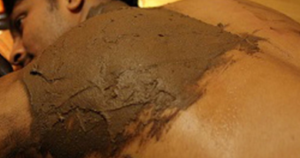
Lepam, often known as “Pooch,” is an Ayurvedic topical treatment that is applied to the skin using medicinal pastes. Depending on the ailment being treated, these pastes—which are made with a variety of therapeutic herbs, oils, and powders—are applied to certain body parts. Here it is customary to use KM Lepam, Karutha Vattu, Rasnadi, and Grahadhoomadi Choornam with Jambeera (lemon).
Benefits of Lepam:
- It aids in pain relief.
- It reduces inflammation and swelling.
- It helps in the reduction of spasms and muscle stiffness.
DHARA:
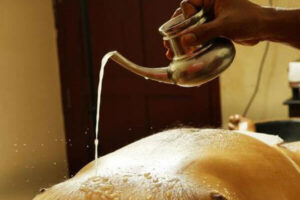
Dhara, a popular Ayurvedic treatment, entails continuously applying medicated liquids to certain body parts, such as the forehead, the body as a whole, or only specific areas.
For this condition, KASHAYA DHARA (DASHAMOOLA KASHYAM) and DHANYAMLA DHARA (DHANYAMLA- a fermented liquid) are helpful.It is normally done about 45 inutes to one hour.
Benefits of DHARA:
- The pouring of warm liquid into the affected area improves blood circulation to the affected area.
- It reduces muscle stiffness and spasticity.
- It reduces pain and inflammation.
- It also improves lymphatic drainage and the elimination of toxins from the body.
ELA KIZHI:

Kizhi, or boluses, are made in Elakizhi using medicinal herbs and massaged after being immersed in heated medicinal oil. Typically, elakizhi is made using castor leaves (Eranda, Ricinus communis), tamarind leaves (Tamarindus indica), arka leaves (Calotropis gigantea), etc.
KOTTAMCHUKKADI and MURIVENNA are the traits used for the same.
Benefits of Ela kizhi:
- Aids in strengthening muscles.
- Relieves aching of joints and muscles.
- Reduces stiffness and discomfort in the body.
- Increases the flow of blood.
NASYAM

Because the nose is considered the entryway to the head, Nasyam, a panchakarma treatment, involves administering herbal oils or powders through the nose.
First, the head, face, and neck are gently massaged. After that, a mild steaming (Swedana) is given to the face and neck to aid in opening the nasal pores. The patient is told to tilt their head slightly while lying on their back. Then, each nostril is filled with the medicinal oil or powder. The patient rests down for a short period of time in order to adequately absorb the medication. Any mucus or phlegm in the patient’s throat should be spat out.
Here, we often practice two forms of Nasyam: Marsha Nasyam and Pratimarsha Nasyam.
a)Pratimarsha Nasya:
- It is a daily, gentler form of Nasya therapy. For preventative care, health maintenance, and dosha balancing, tiny doses (1-2 drops) of medicinal oil are administered. For the same reason, Anu Taila is typically preferred.
b)Marsha Nasya:
- A greater amount (6–10 drops) of medicinal oil or powder is administered through the nose as part of this therapeutic technique. Here, we typically employ Ksheerabala Taila.
Benefits of Nasya:
- It balances Vata Dosha.
- It improves circulation and lubrication.
- It relieves pain and stiffness.
- It strengthens the nervous system and joints.
- It prevents further degeneration.
ROOKSHA VASTHI:
Rooksha Vasthi is a kind of medicinal enema primarily dry and non-unctuous. It is a subtype of purificatory enema, or Shodhana Vasthi, and is mostly used to balance the body’s exacerbated kapha and Medas (fat tissue). The patient is positioned with the right leg bowed and the left leg extended in the Vama Parshwa, or left lateral position. With a dry or less oily preparation, the anal region is only lightly lubricated. In a Vasthi device, the dry powder suspension or medicinal decoction is filled. It enters the rectum gradually through the annal canal. For a predetermined period, the patient is told to keep the medicine. The dry nature of the formulation results in a shorter retention than with Sneha Vasthi (oil-based enema). It typically lasts three to seven days as part of a therapy strategy.
Benefits of Rooksha Vasthi:
- It reduces kapha and Ama(toxins).
- It relieves pain and stiffness
- It enhances nerve conduction.
- It balances Vata Dosha.
- It can also provide anti-inflammatory effects.
- It improves digestion and absorption.
ROLE OF PHYSIOTHERAPY IN SYRINGOMYELIA:
Key roles in Physiotherapy in Syringomyelia:
1. Pain Management:
Syringomyelia can cause neuropathic pain, musculoskeletal pain, and headaches, physiotherapists use different pain relief strategies.
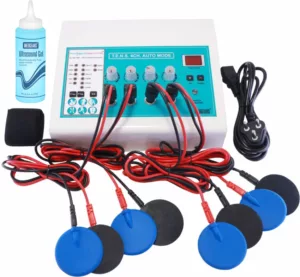
- TENS(Transcutaneous Electrical Nerve Stimulation) helps modulate pain perception by stimulating the nerves and reducing discomfort.
- Heat Therapy: Applying warm packs or hydrotherapy to relax stiff muscles and improve circulation.
- Cold Therapy: Useful for reducing inflammation in cases of acute pain or swelling.
- Soft tissue mobilization and myofascial release: Hands-on therapy to reduce muscle tension and improve blood flow.
2. Postural Correction and Ergonomic Training:
Patients with syringomyelia often develop poor posture due to muscle weakness and spinal deformities. Physiotherapists focus on:
- Postural awareness training: Educating patients on maintaining proper spinal alignment.
- Ergonomic modifications: Adjusting workstations, chairs, and daily activities to reduce strain on the spine.
- Bracing and supportive devices: In severe cases, spinal braces may help stabilize posture.
3. Strengthening and Stabilization Exercises:
Strengthening exercises aimed at improving muscle function, preventing atrophy, and enhancing mobility.
Strengthening Exercises:
A)Upper Limb Strengthening:
- Isometric shoulder exercises.
- Resisted shoulder and arm movements.
- Grip strength Exercises.
- Wall push-ups.
B)Lower limb Strengthening:
- Seated knee extension.
- Heel and Toe raises.
- Bridging exercises.
- Mini squats.
Stabilization Exercises:
Spinal stabilization exercises focus on improving core control and balance, preventing excessive movement that may worsen symptoms.
A)Core Stabilization:
- Abdominal Bracing.
- Pelvic Tilts.
- Modified Planks.
B)Spinal and Postural Stabilization:
- Seated Posture Training.
- Scapular retraction.
- Bird dog exercise.
C)Balance and Coordination Training:
- Single Leg Stance.
- Tandem walking.
- Swiss Ball exercises.
4. Flexibility and Range of Motion Exercises:
Since syringomyelia frequently causes stiffness, physiotherapists use gentle stretching techniques to increase flexibility.
- Give particular attention to the neck, shoulders, back, and limbs.
- Joint mobility can be maintained without undue pressure on joints with passive and active assisted range-of-motion exercises.
5. Balance and Coordination Training:
Proprioception, bodily awareness, and coordination can be impacted by syringomyelia, making it difficult to stand or walk.
- Using a balancing board, wobble cushions, and stability drills to improve bodily control is known as proprioceptive training.
- Gait training is the process of adjusting walking patterns to increase mobility and lower the risk of falls.
- Exercises involving the vestibular and visual systems can help manage vertigo or balance issues.
6. Breathing and Relaxation techniques:
Physiotherapists include the following because syringomyelia might create breathing problems if it affects the cervical spine:
- Diaphragmatic (abdominal) breathing: Enhances oxygen delivery and lung function.
- Pursed lip breathing: If there is respiratory weakness, pursed lip breathing helps control breathing, avoid air tapping, and enhance lung function.
- Deep breathing with thoracic mobility exercises: Thoracic mobility exercises combined with deep breathing help to expand the rib cage and lessen stiffness.
Benefits of Physiotherapy in Syringomyelia:
- Pain reduction: Soft tissue work, heat therapy, and TENS are among the methods that assist lessen chronic pain.
- Increased muscle strength: Exercise that builds muscle improves motor function and keeps muscles from atrophying.
- Improved Postural Control: Postural training lessens pain and strain on the spine.
- Improved gait and mobility: Assists patients in walking more easily and carrying out everyday tasks.
- Improved range of motion and flexibility: Stretching preserves joint mobility.
- Lower risk of injuries and falls: Balance training increases stability and coordination.
- Better quality of life: In general, physical therapy encourages self-reliance and functional rehabilitation.
ROLE OF ACUPUNCTURE IN SYRINGOMYELIA:
For the treatment of syringomyelia, a disorder in which a fluid-filled cyst (syrinx) develops in the spinal cord and may result in discomfort, weakness, and neurological problems, acupuncture can be a helpful therapy. It can enhance quality of life and aid in symptom management.
Techniques of Acupuncture for syringomyelia:
a)Traditional Acupuncture:
- Points along the Du Mai(Governing Vessel) meridian and Bladder meridian may be used to regulate spinal energy flow.
- Common points: DU14(Dazhui), BL23(Shenshu), LI4(Hegu), and ST36(Zusanil) for pain relief, nerve function, and immune support.
2.ElectroAcupuncture(EA):
- Mild electrical Stimulation is applied to needles to enhance pain relief and nerve function.
- Helps improve circulation and reduce inflammation around the spinal cord.
Benefits of Acupuncture in Syringomyelia:
- Pain management: Reduces neuropathic pain by stimulating endorphin release and modulating pain pathways.
- Improved nerve function: This may help in reducing sensory deficits and improving muscle control.
- Reduced Inflammation: Stimulates circulation and lymphatic drainage to minimize swelling.
- Muscle Relaxation: Eases muscle spasms and tension caused by nerve compression.
- Enhanced blood flow to the spine: Helps maintain spinal cord Health and slow disease progression.
- Better sleep and mental well-being: Helps with anxiety, depression, and sleep disturbances caused by chronic pain.
DIET RECOMMENDATIONS IN OUR HOSPITAL:
Our senior physicians suggest to avoid
- Milk, milk products, cold food, pickles, fruits, dry fruits, nuts, fast food, fried and oily foods.
- Fermented foods like dosa, idli, and fermented appam.
- Tuber items like potato, tapioca, and sweet potato.
- Nonvegetarian items like, Fish, egg, and meat(Can be taken in curry form, if necessary).
A few recommended food items to be taken are:
- Hot kanji.
- Steamed food items like idiyappam, put, and chapati.
- Vegetable in boiled form.
General Suggestion:
- Avoid strenuous activities.
- Drink enough water(2.5L-3L).


